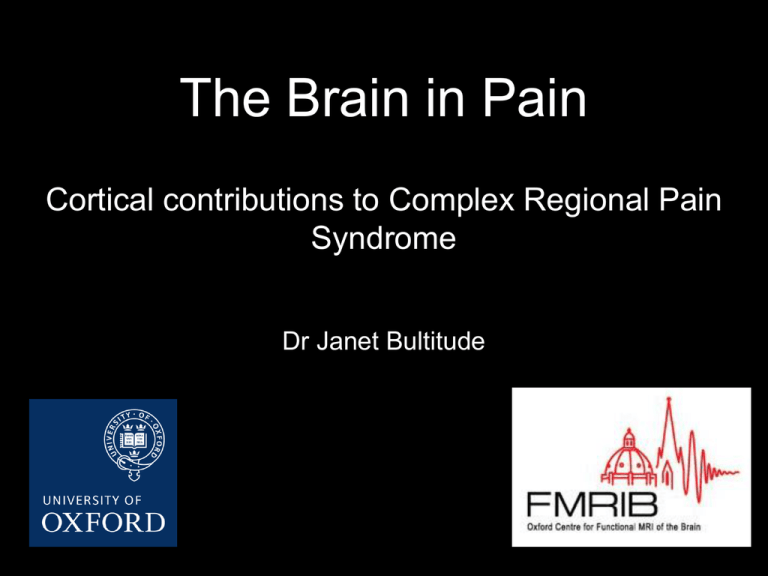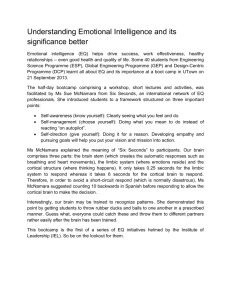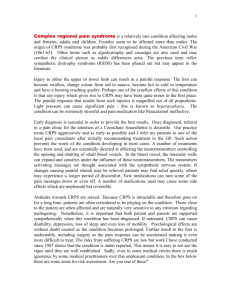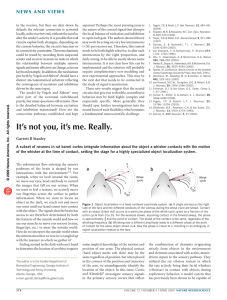janet_bultitude_key_note_from_cardiff_2013
advertisement

The Brain in Pain Cortical contributions to Complex Regional Pain Syndrome Dr Janet Bultitude Overview 1. Cognitive and cortical changes in CRPS 2. Possible role in clinical symptoms 3. Implications for treatment 4. Proposed mechanisms Complex Regional Pain Syndrome Complex Regional Pain Syndrome “As the pain increases, the general sympathy becomes more marked. The temper changes and grows irritable, the face becomes anxious, and has a look of weariness and suffering. The sleep is restless, and the constitutional condition, reacting on the wounded limb, exasperates the hyperaesthetic state, so that the rattling of a newspaper, a breath of air…the vibrations caused by a military band, or the shock of the feet in walking, gives rise to increase of pain.” Silas Weir Mitchel, 1864 Distorted body representation Lewis et al., 2010, Pain Distorted body representation • “I feel disgust, I know it sounds a very strong word to use but I’m disgusted that my arm is this way.” • “It was just like this foreign body you were carrying around with you cause it didn’t feel like it was part of you.” Lewis et al., 2007, Pain Distorted body representation • Difficulty locating / moving the limb unless directly looking at it • Difficulty identifying fingers from touch • Referred pain, or pain when viewing an object approaching the limb • Movement-induced pain greater when viewing hand through magnifying lens, less when viewing hand through minimising lens. Cortical reorganisation Maihöfner et al., 2004, Neurology Cortical reorganisation Gieteling et al., 2008, Pain Mechanisms of CRPS “When our senses present us with discordant information, such as when our eyes give our brain information that does not agree with our senses of body position, balance, and equilibrium, we feel nausea. Less familiar is the notion that discordance between awareness of motor intention, muscle and joint proprioception, and vision may result in our feeling pain.” 1999, The Lancet Poke your eye Predictive signal True sensory outcome ??? Predictive signal True sensory outcome Implications for treatment ??? Predictive signal True sensory outcome Healthy hand representation Healthy hand representation Predictive signal True sensory outcome ??? Predictive signal True sensory outcome Prism adaptation Prism adaptation Sumitani et al., 2007, Neurology Prism adaptation Transcranial Direct Current Stimulation Transcranial Direct Current Stimulation Antal et al., 2010; The Clinical Journal of Pain Proposed mechanisms Immobilization-driven reorganisation? Immobilized IF Healthy IF Lissek et al., 2004, Current Biology Direct immune mechanisms? Overview 1. Cognitive and cortical changes in CRPS 2. Possible role in clinical symptoms 3. Implications for treatment 4. Proposed mechanisms Take-home messages Cortical origins to pain ≠ It’s all just in your head Take-home messages • Importance of: – Early recognition – Aggressive intervention – Multiple simultaneous approaches – Cognitively- and cortically-targeted treatments Now recruiting We are looking for volunteers with CRPS for a study investigating two potential treatments that target cognitive and cortical changes. Interested patients can contact me at crps@fmrib.ox.ac.uk or jbultitude@fmrib.ox.ac.uk







